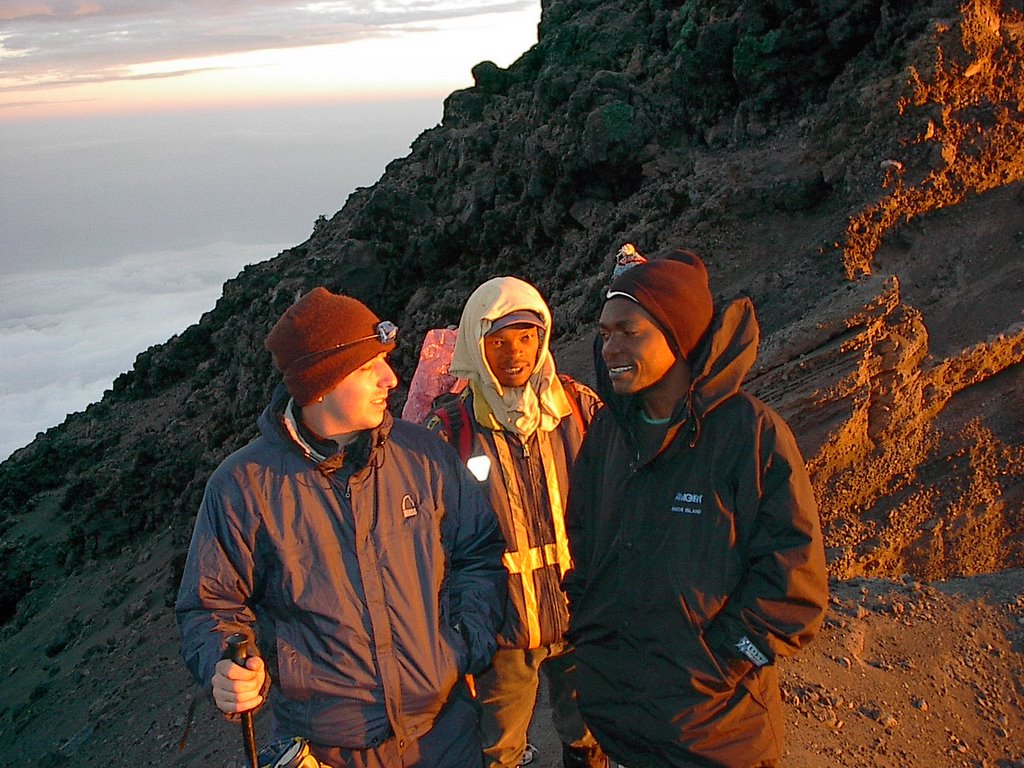Monday, October 29, 2007
Where are the Graves?
with Jill Valentine

Jill is joined for the walk home along one of Ngonga's many paths
Where are the graves? That is the question someone once asked me when I had brought them to Friends of Tanzania’s “Watoto Wetu (Our Children)” project in Kyela, Tanzania. It was a good question considering how we had previously discussed in length the impact of the AIDS pandemic in the District. According to TACAIDS statistics Kyela is the second hardest hit district in Tanzania with 13.5% of its inhabitants infected with HIV. The question was simple and honest…if the infection rate is high, the number of people on ARVs low and the health system inadequate one must assume that there are a lot of deaths (and sadly there are)…but then why are there no cemeteries? Why are there no mass graves? With the rhetoric of AIDS campaigners, using such words as "PANDEMIC", this volunteer expected to see corpses stacked in piles. The truth is there were none, and that is precisely why the AIDS pandemic continues to rage on. In Africa, AIDS is a slow Tsunami that just is'nt going away.
After two months away, September 20th was my first night back in Ngonga village. I had come with a Canadian and a Swiss volunteer who were helping to dig a well, install solar panels and paint the newly built school kitchen. After a twenty hour voyage we hit our beds like sacks of rocks. At around 3a.m. the silence of the night was broken by the piercing cry of a woman’s screams. The screaming grew louder as more women joined in the chorus. After an hour or so the screaming subsided and was replaced by waves of wailing from a dozen or so women in mourning. This haunting sound of wailing fills the night air far too often in Ngonga and sadly this time is was because our neighbour had died.
Our neighbour was in his early 50s and was sick for a long time with everything but HIV. According to friends he had fever, he had malaria and he had pneumonia “but he did not have HIV.”
Around noon the following day the village had assembled on the piece of land that lies in between the main trail and the family property. It is a sliver of land maybe 8 meters in width. Village rules prohibit anybody from building on land along the trails as it is reserved for graves. The trees and bamboo can be harvested and property can be claimed but any major disturbance to the land is prohibited.
The hastily made preparations for the funeral were in accordance to Kynakusa customs. The body was wrapped in a simple grass mat and placed on a bamboo bed frame. This makeshift coffin was then carried by six men to the burial site followed by his weeping wife and family, the village elders, friends and neighbours, and finally, by a throng of young boys who had joined the procession because they had nothing else to do.
A five foot hole had been dug a few feet from the trail. The family gathered on one side on other grass mats they had brought along and watched while the body of their loved one was placed into his final resting place. About a hundred people had gathered around the small grave to bid their farewells. Closest to the grave the family wept and wailed consumed by their sorrow, across from them an impromptu chorus began singing upbeat hymns, while the others socialized and joked around. As outsiders we were surprised to see such jovial behavior in a time of sadness, but admitted to ourselves that to attend six funerals in a week would numb even the most emotional of people. After the last song was sung the speeches began. First was immediate members of the family, then the woman who rented his rice fields, followed by the pastor and finally by the oldest man in the village. The speeches paid respect to the family and to the deceased.
Once the speeches were finished everyone took their turn throwing a handful of dirt into the grave. The woman who sells local brew broke out in tears and ran away screaming, “I have lost my beloved drinking partner.” Soon the handfuls of dirt were replaced by shovels full and the grave was quickly filled with a mound formed on top. Two mud bricks are place at either end to demarcate the location of the burial site. The crowd disburses and we returned home…the funeral was over by early afternoon.
In time the mound of dirt and two mud bricks that mark the grave will slowly sink and break down and by the end of the next rainy season will no longer be visible. Like the mud bricks, the body and grass mat will also quickly breakdown and within a few years our neighbour will have made a full return to mother earth. Like mother earth, those still living will quickly forget the death of their fellow villager. He has become just another tree in a forest of funerals. His grave will have grown over with new vegetation just as their memories will have grown over with the losses of many more beloved ones.
